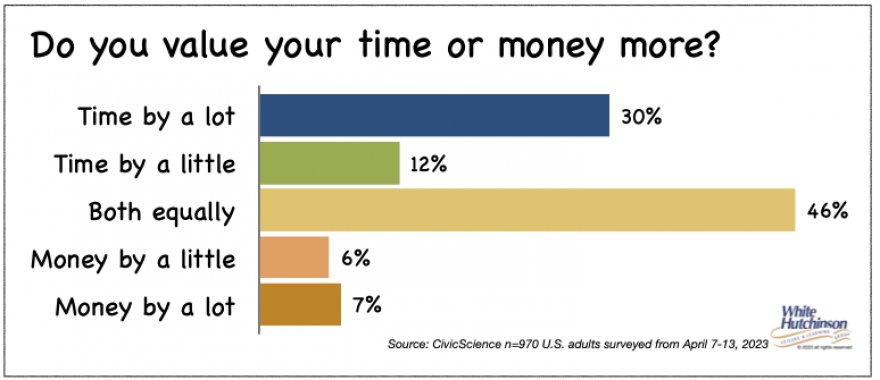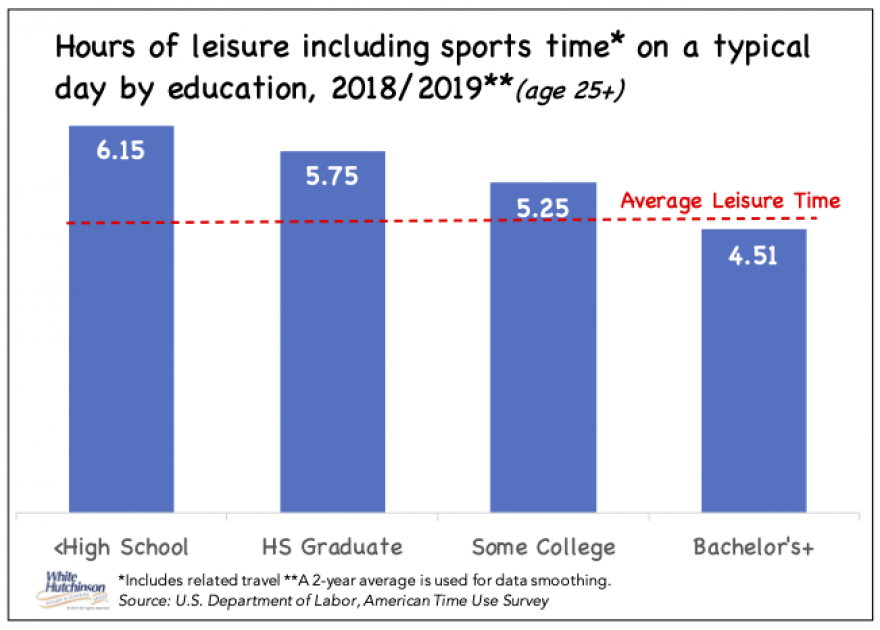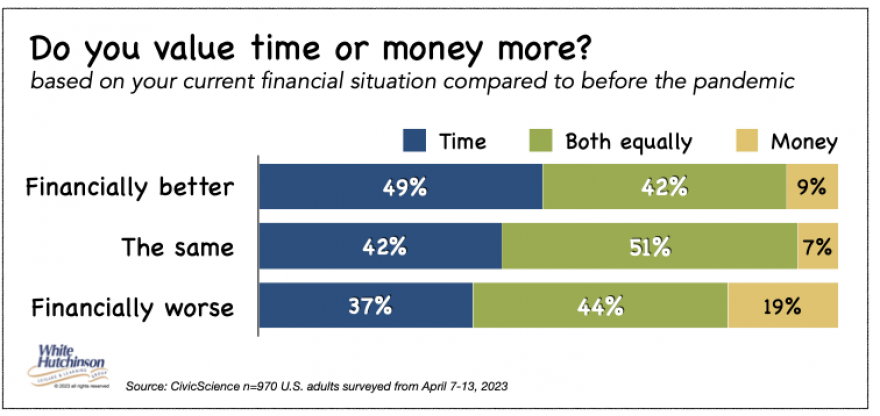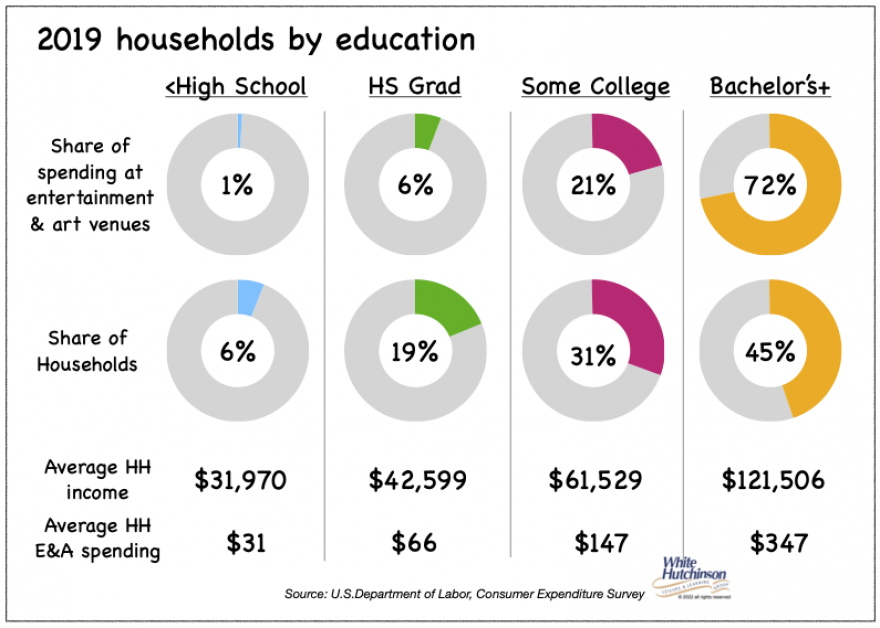
Vol. XXIII, No. 4, April 2023
- Editor's corner
- Are Dave & Buster's same store sales really increasing?
- The Big Mac index
- Satisfaction with attraction visits is down
- How much is time at your venue worth? Understanding the money value of time
- Gen Z slang
- Industry veteran still going strong at 90
- Human contact is becoming a luxury - The rise of participatory social eatertainment
- Possible explanation for declining births
- Who will pay extra fees for the ideal seats in a movie theater?
- More about the weekday daytime leisure economy
How much is time at your venue worth? Understanding the money value of time
Time is more valuable than money. You can get more money, but you cannot get more time.
We only have so much time, 24 hours a day, 7 days a week. When it comes to disposable leisure time, it's far less, on average 5 hours, 10 minutes a day. Since time is limited, we want to use it wisely. When choosing what out-of-home (OOH) entertainment and leisure venues to visit, time well spent at some is more valuable than at others. One way to measure that value is the 'money value of time' (MTV). MTV recognizes that the amount of money customers will pay for a OOH commercial experience is directly proportional to the value they receive from the time they spend there.
This has three implications:
- If there is no charge for the time, people will naturally assume that the offering is probably not worth experiencing.
- The more time well spent, the more money customers should be willing to pay.
- MTV allows an experience charging a fee to measure itself against other experiences using the MTV scale of expenditure per minute.
A movie at your local cinema usually lasts about 2 hours, and the ticket costs $12. We value the time watching the movie at 10 cents a minute. But if it is a blockbuster film and we see it on an IMAX screen, the ticket might cost $15, or 12.5 cents a minute. We consider the IMAX viewing a better experience and will pay more for it.
Disney parks work out to around 20-25 cents per minute.
Now let's look at the MTV of a go-kart ride. The ride might cost $6 and only takes about 5 minutes. But we likely must stand in a queue to ride for maybe 15 minutes. We'll assume the total experience takes 20 minutes. MTV works out to 30 cents a minute.
But escape rooms have an even higher MTV of around 50 cents per minute.
If the go-karts are located at a location-based entertainment venue (LBE), such as a family entertainment center with other attractions, MTV for visiting the venue would be the total of all fees and admissions divided by the length-of-stay in minutes (not counting any time spent eating in its restaurant). If that was $25 and the length-of-stay was 1.5 hours, then MTV would be 28 cents per minute.
Actual MTV would include the total per capita cost of attending, including food and beverage, retail, and any parking fees. Still, these are generally not publicly available for comparison purposes.
Americans generally say their time is either more or equally important as money, according to CivicScience's poll this month. Four-in-10 Americans (42%) value time over money, while 46% value it equally. A small minority value money more (13%).

To increase revenues, OOH commercial experiences might consider expanding the length-of-stay assuming they could maintain the same MTV for the lengthened experience. The problem with this might be that the length of stay could deter attending. People might be willing to attend a 2-hour experience (remember that doesn't include the time traveling to and from the event), but a 2.5-hour experience with the travel time might not fit into their schedule.
The best way to increase revenues is to increase the MTV of the experience and raise prices. This requires raising the fidelity of the experience, improving its quality and uniqueness. When you raise MTV, you also create a competitive advantage over other options.
An aspect of MTV that is often overlooked is that the money value of time is greater for higher socioeconomic people than lower socioeconomic. The reason is that people from higher socioeconomic households have the least leisure time (74 minutes less a day than a high school graduate), meaning they will definitely want to avoid wasting it and time well spent is even more valued by them. This large market of customers can afford to pay higher MTVs.

A CivicScience poll this month found that the pandemic increased the value of time for many people. Three in ten Americans now say that time is more important than before the pandemic (30%), while fewer say that money is more important (13%). For 57%, their values have stayed the same from pre-pandemic years.
Nearly half of those who are now financially better off than before the pandemic (49%) and 42% who are financially the same say time is now more important to them. Even over one-third of those worse off financially (37%) say time is now more important to them. The wealthier people are, the more they value time over money.

Higher socioeconomic households with their higher incomes can afford to pay the higher MTV for high-fidelity experiences. And with time so valuable to them, they will seek out high MTV experiences to ensure their time is well spent and not wasted. They are the prime market for out-of-home OOH leisure and entertainment. Using pre-pandemic data, nearly three-quarters of all spending on OOH entertainment and art venues (71%) was by households with a person with a bachelor's degree or higher. Their average OOH entertainment and art spending for fees and admissions was more than five times what high school graduate households spent.

The bottom line is that the largest OOH leisure and entertainment market is higher-socio-economic households who can afford and are willing to pay higher MTVs for higher fidelity experiences to ensure that their time is well spent. With the post-pandemic increase in the importance of time over money, the higher-socio-economic household will be migrating their OOH entertainment and leisure experiences to the higher MTV venues.
Subscribe to monthly Leisure eNewsletter
Vol. XXIII, No. 4, April 2023
- Editor's corner
- Are Dave & Buster's same store sales really increasing?
- The Big Mac index
- Satisfaction with attraction visits is down
- How much is time at your venue worth? Understanding the money value of time
- Gen Z slang
- Industry veteran still going strong at 90
- Human contact is becoming a luxury - The rise of participatory social eatertainment
- Possible explanation for declining births
- Who will pay extra fees for the ideal seats in a movie theater?
- More about the weekday daytime leisure economy


